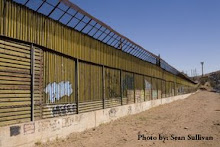By Scott
Nicol
The United
States section of the International Boundary and Water Commission (US IBWC)
recently hosted a meeting in Rio Grande City to explain their decision to allow
Customs and Border Protection to build new border walls in the Rio Grande
floodplain. While they should be
commended for reaching out to local residents, they seemed completely
unprepared, unable to answer the most basic questions about their decision or
the new walls.
When, for example, landowners asked whether there had
been any on-the-ground surveys, and what the wall would mean for access and
impacts to their property, they got no response.
The manager for Rio Grande City’s international bridge
and port of entry asked how they would be able to access the riverbank to carry
out ongoing erosion control efforts. US
IBWC did not know.
Residents asked whether walls crossing the washes that
feed into the Rio Grande might become blocked with debris, preventing normal
drainage and causing flooding. At that
point US IBWC admitted that even though they approved these new walls months
ago, Customs and Border Protection still has not provided them with the walls’
design specifications, so they could not answer that question either.
2007 Bureau of Land Management photo of debris in the Arizona wall
US IBWC was also unable, or unwilling, to answer a key question
about the flood model that they are using to justify their approval of border
walls in the floodplain.
Using the Freedom of Information Act the Sierra Club has gotten a copy
of the flood model, as well as a number of related documents.
The model’s computer program cannot add to this number, cannot
decide that it is too low and that in reality more debris will clog the spaces
between bollards. By telling the
computer that 75% to 90% of floodwater will pass through the wall, Baker effectively
predetermined the model’s end result.
At the meeting in Rio Grande City, surrounded by
residents whose lands and lives will depend on whether or not these walls will actually
let water pass through or will dam it up, US IBWC could not explain where the
suspiciously round and suspiciously low estimate of 10% - 25% debris blockage
came from.
In earlier reports Baker Engineering came to a very
different conclusion about how much debris border walls were likely to catch.
Photo from the 2009 Baker report showing debris in the Arizona border wall
In examining on-the-ground evidence of debris clogging
border walls, it bolstered a 2008 Baker Engineering white paper that looked at
the likely impacts of the walls planned for Roma, Rio Grande City, and Los
Ebanos. In discussing the wall’s
transfer capacity - the ability of water to pass between the bollards - it
stated that,
Map of the three new border walls from the 2011 Baker flood model
So how did Baker’s
estimates of clogging drop from 85%, 67%, and 36% down to 10% where the wall is
parallel to the Rio Grande, and from 100% down to 25% where it is
perpendicular?
The US IBWC has yet to give
the public an answer to that question.
The new flood model,
with its low debris estimate, is cited by the US section of the International
Boundary and Water Commission as the basis for its decision to allow these
border walls. The Mexican section has
rejected the model’s assumptions, countering in late 2011 that these walls
would likely obstruct
60% - 70% of flood flows even before the clogging effect of debris is
factored in.
On February 9, 2012 the
two sections of the bi-national organization met to discuss their
disagreement. Meeting notes written by
the same US IBWC engineer who was unable to answer questions about the model’s
assumptions at the Rio Grande City public meeting say that,
So even when they met with their Mexican counterparts, US
IBWC gave no concrete evidence that the lower estimate was more accurate than
the earlier, much higher one. The nice,
round, low number was \simply “felt to be reasonable”, despite conflicting with
empirical evidence from Arizona, and was adopted because it matched up with the
Department of Homeland Security’s desire for a model showing a “minimum debris
blockage.”
Not only was Mexico’s estimate ignored, they were not
even invited to participate in the 2011 modeling methodology meeting. And six days after the 2012 meeting the US
section, flouting its treaty obligations, unilaterally approved Customs and
Border Protection’s request to build walls in the floodplain.
Customs and Border Protection photo of debris backed up behind the border wall
Customs and Border Protection (CBP) has not hosted a
public meeting on border walls in South Texas since 2007, but they did send a
representative to the recent Rio Grande City meeting. He declined to present
any information, and remained silent unless he was asked a direct
question.
When asked when CBP would begin construction he said that
at this time they do not have the funds to build these walls. He failed to mention that CBP bought the
steel years ago and currently has it in storage. More importantly, he failed to mention that
the new fiscal year for federal agencies begins on October 1, at which time
their bank accounts will be refilled.
If border residents want answers, we need to demand them
now.
Representative Cuellar and Senators Hutchison and Cornyn
need to pressure the US IBWC to reverse its bad decision, and direct Customs
and Border Protection to finally give up on these dangerous walls. They need to take concrete action, and they
need to do it now.
But of course they won’t, unless we, their constituents
and voters, tell them to.
October is only three weeks away. The clock is ticking.










 A border patrol surveillance tower and the border wall visible at the end of a Brownsville cul-de-sac.
A border patrol surveillance tower and the border wall visible at the end of a Brownsville cul-de-sac. 








